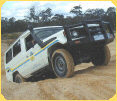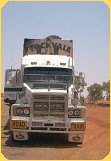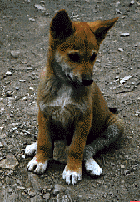 |
 |
|
|
|
||
|
Outback Info (Private Seiten) © seit 1999 THE DINGO FAMILY In his natural state the Dingo lives either alone or in a small family group differing from many other wild dog species which may form packs. Dingoes have a clearly defined territory which they rarely leave, but which may be shared with other Dingoes which sometimes co-operate in hunting larger prey. The size of the home territory varies according to the food supply. Dingoes mate for life with the bitch coming into season once per year, normally between May to July (winter) and the pups are born from July to September (winter to spring). The level of testosterone in the male Dingo rises during the breeding season. Within an established social group only the alpha male and female will mate.Gestation is 63 days, the same as in domestic dogs. Both parents take part in raising the pups. Litters average about five pups. At fourteen days old the mother regurgitates food for the pups and by the age of three weeks, when they will leave the den for short ventures, they are able to eat rabbit. The sire may help feed the pups, as may other male and female Dingoes from within the social group. Prey around the den is not captured but left to allow the pups to practice their hunting skills. Canis lupus familiaris dingo. The origins of the Dingo are obscure. It is not truly native to Australia but is thought to have arrived between
3500 and 4000 years ago. The oldest Dingo fossil found has been carbon dated at
3450 years old - the approximate era at Dingoes have never been on the island State of Tasmania which separated from the mainland some 10,000 years ago. According to latest DNA testing, Dingoes evolved 135,000 years ago and were the world's first domestic dog, predating the wolf. A 'marker' has been found in the Dingo which is not present in the wolf, making the Dingo a separate species. It is believed that the Dingo is the ancestor of all dog breeds, the base stock of the 600 true dog breeds. Currently there are two scientific theories as to the Dingoes origins and arrival in Australia. One is that the closest relatives of the Dingo were dogs bred on the delta of the Indus River in India 3000 years ago. This theory believes that the Dingo was domesticated and reached Australia via Timor with Indian Traders. The second theory is that the Dingo is closely related to the semi wild dogs widely distributed throughout south east Asia and that the Dingo accompanied sea farers to Australia. It is likely that the Dingo was traded to the Aborigines or, having been semi domesticated in Asia, it chose to associate with the natives for the benefits of a mutual association. Whatever its origins, the Dingo was a highly valued companion to the Aborigines - they lived, ate and hunted with their human keepers. They were their bed warmers, camp cleaners, hunting companions and guard dogs. The Aborigines took puppies from wild litters each breeding season, but upon reaching maturity most of these dogs reverted to the wild lifestyle. Puppies were often suckled by the women of the tribe. Dingo Farm has the original glass negative of this photo taken in 1890. Given to Bruce Jacobs by the great grandson of the photographer, it can be used by natural history researchers and documentary makers.
|
Schatzsuche in Down Under / Fossicking
|
||||||||||||||||||||||||||||||||||||||||||||||||||||||||||||||||||||||||||||||||||||||||||||||||||||||||||||||||||||||||||||||||||||||||||||||||||||||||||||||||||||||||||||||||||||||||||||||||||||||||||||||||||||||||||||||||||||||||||||||||||||||||||||||||||||||||||
Australien-Kanal.de © seit 1999, Fossicking.de © seit 1999





